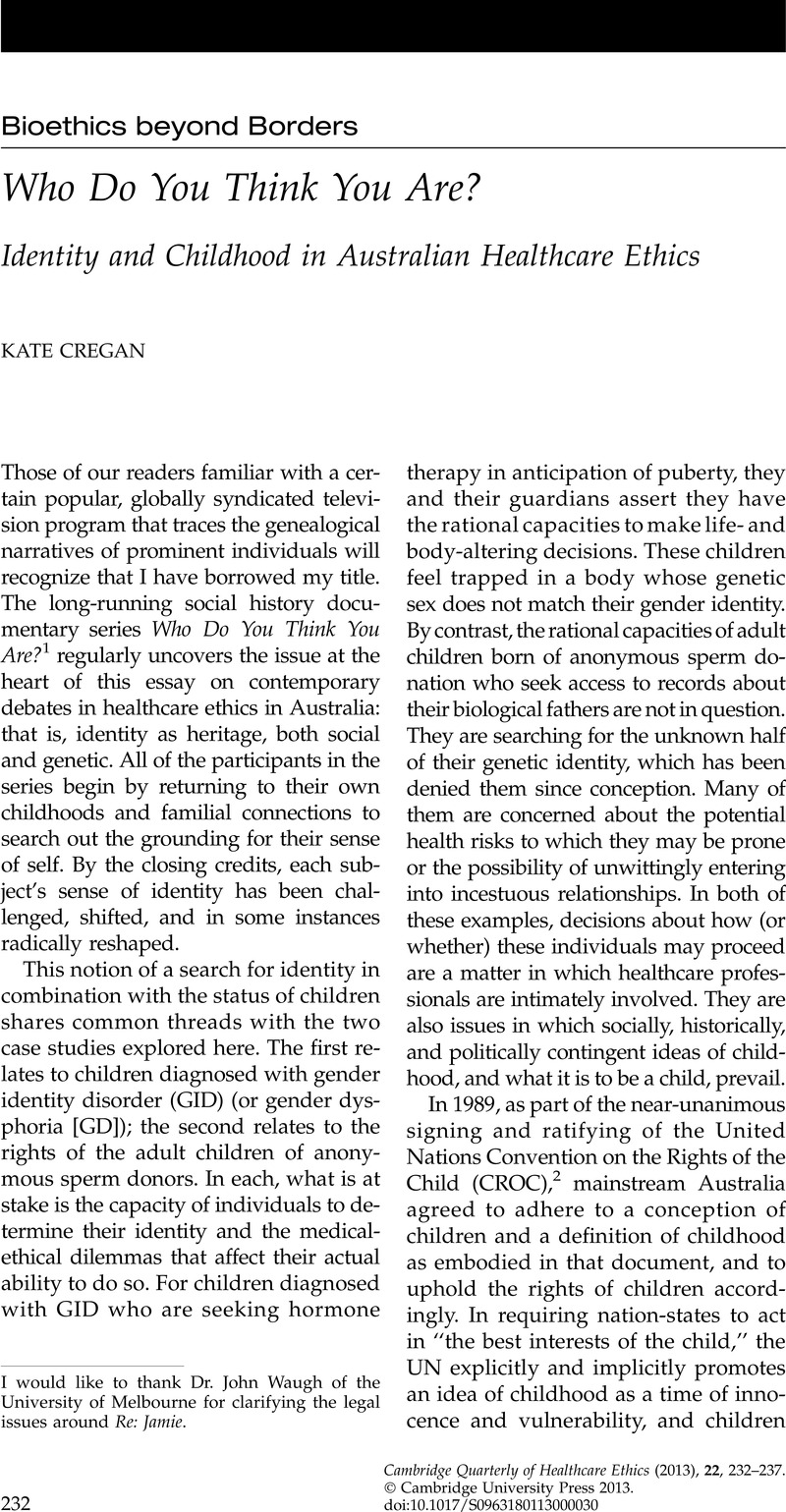No CrossRef data available.
Article contents
Who Do You Think You Are?
Identity and Childhood in Australian Healthcare Ethics
Published online by Cambridge University Press: 30 April 2013
Abstract

- Type
- Bioethics beyond Borders
- Information
- Copyright
- Copyright © Cambridge University Press 2013
References
Notes
1 Who Do You Think You Are? Wall to Wall and BBC 1, 2004–2012.
2 United Nations. UN Convention on the Rights of the Child 1989; available at http://www2.ohchr.org/english/law/crc.htm (last accessed 29 Nov 2012). Australia became signatory in 1989 and ratified it in 1990, and it came into force for Australia in 1991. Only three member states of the UN are not party to the CROC: Somalia and South Sudan have neither signed nor ratified the Convention, and the United States has signed but not ratified.
3 Ariès, P. Centuries of Childhood: A Social History of Family Life. Baldick R, trans. New York: Alfred A. Knopf; 1962.
4 Laws on the age for consensual sexual activity vary from state to state and range from 16, to 17, and to 18, although the last only applies in Queensland, and specifically for anal sex. Defenses may also be made for consensual sex at younger ages for a range of reasons. See http://www.aifs.gov.au/cfca/pubs/factsheets/a142090/index.html (last accessed 1 Dec 2012).
5 Family Court of Australia. A Question of Right Treatment: The Family Court and Special Medical Procedures for Children, an Introductory Guide for Use in Victoria, with a foreword by Chief Justice Alastair Nicholson. Melbourne: Family Court of Australia Publications Unit; 1998, at vii.
6 See note 5, Family Court of Australia 1998, at vi.
7 See note 5, Family Court of Australia 1998, at 2.
8 Robotham J. Child sex-change ruling fails to solve the confusion. The Age 2012 Feb 11.
9 See note 8, Robotham 2012.
10 Stewart C, Cockburn T, Madden B, Callaghan S, Ryan CJ. Leave to intervene in cases of gender identity disorder; normative causation; financial harms and involuntary treatment; and the right to be protected from suicide. Journal of Bioethical Inquiry 2012;9:235.
11 See note 10, Stewart et al. 2012.
12 For more general information and a list of publications arising from the ARC-funded History of Adoption Project, see http://www.arts.monash.edu.au/historyofadoption/index.php. (last accessed 1 Dec 2012).
13 Broadbent A, Bentley R. Adoptions Australia 1995–96. Child Welfare Series no. 19. Cat. no. CWS 3. Canberra: AIHW; 1997.
14 AIHW. Adoptions Australia 2010–11. Child Welfare Series no. 52. Cat. no. CWS 40. Canberra: AIHW; 2011.
15 A raft of tests is required to identify and exclude donations infected with transmissible diseases and some genetic conditions. The figure of AUD 350 is based on one clinic’s pricing schedule: http://www.spermdonorsaustralia.com.au/how-start (last accessed 29 Nov 2012).
16 Hagan K. More time needed for egg, sperm donor decision. The Age 2012 Oct 12.
17 See note 16, Hagan 2012.
18 See note 16, Hagan 2012.
19 Again, the dates of legislation vary from state to state, but formal adoption was not possible until the late 1920s. My own father’s adoption in Victoria was not formalized until 1930, when he was 10, under the Adoptions of Children Act 1928, although he had been with the people he believed to be his parents from the age of 3. See also the History of Adoption Project, http://www.arts.monash.edu.au/historyofadoption/index.php (last accessed 29 Nov 2012).
20 See Pollard A. From secrecy to openness: The Victorian adoption reform movement, [doctoral dissertation]. Monash University, under examination; Cuthbert D, Quartly M. Forced adoption in the national story of apology and regret. Australian Journal of Politics and History 2012;58(1):82–96.
21 See Cuthbert D, Cregan K. Global Childhoods: Issues and Debates. London: Sage; Forthcoming, for deeper discussions of the issue of children as objects of national and global concern.




